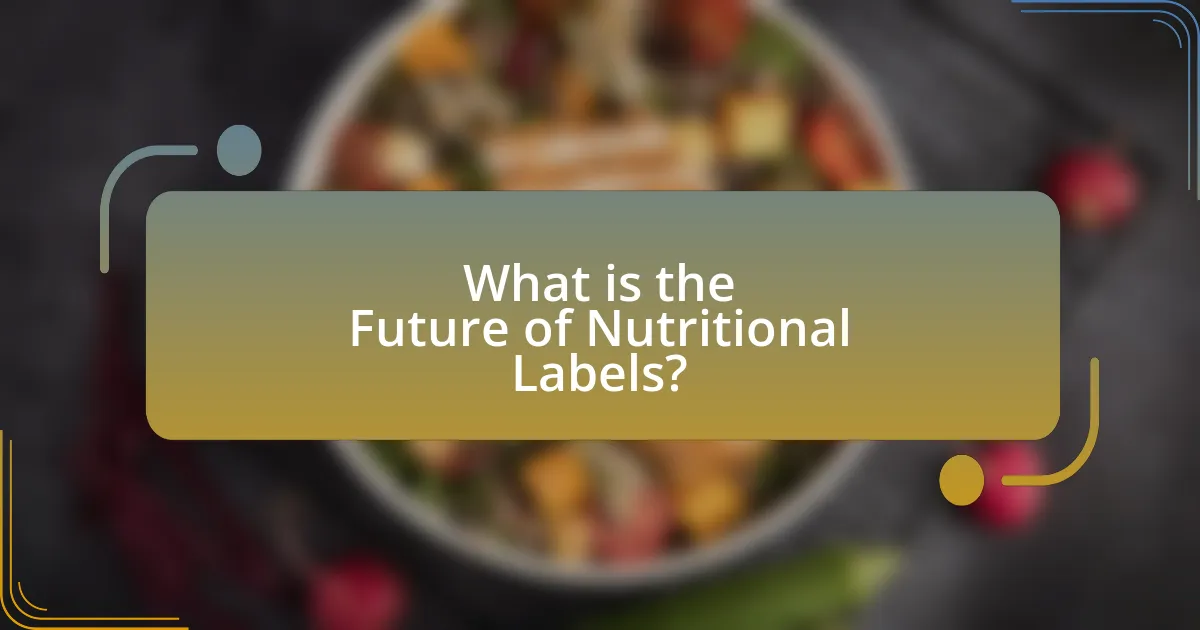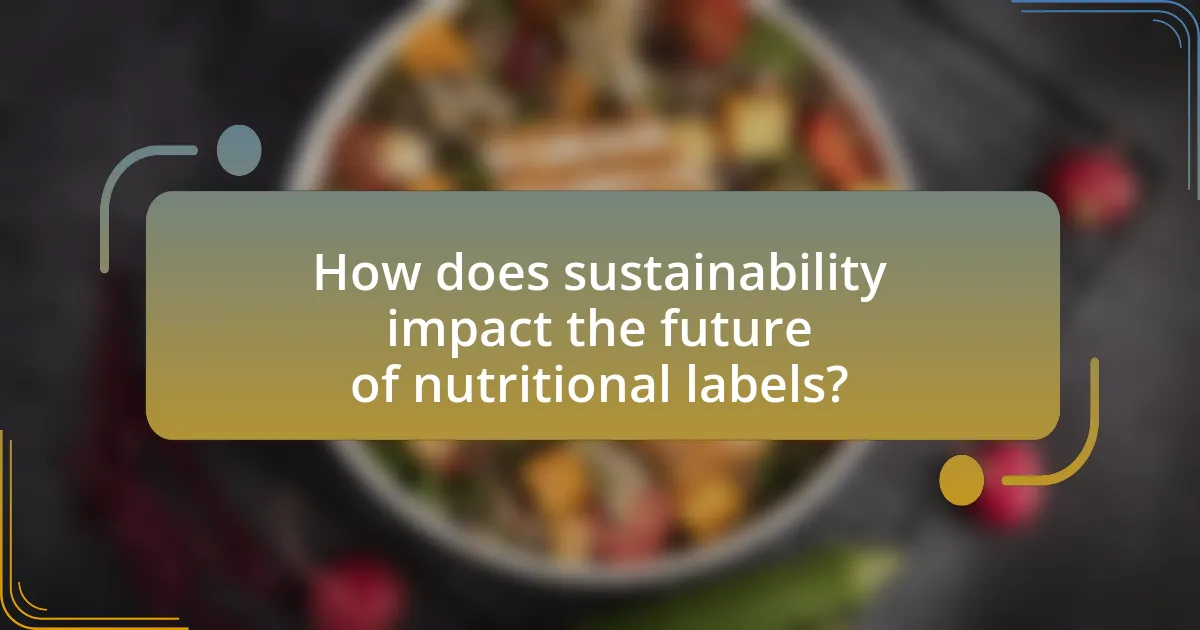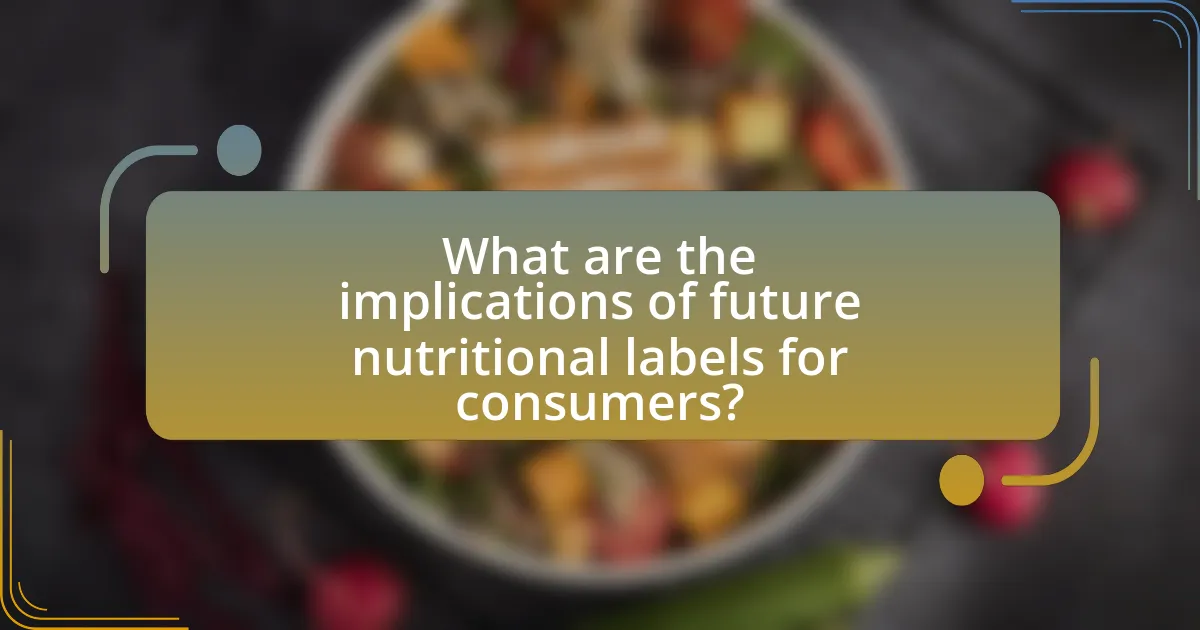The article focuses on the future of nutritional labels, emphasizing the importance of transparency and sustainability in food labeling practices. It outlines how consumer demand for clearer information regarding ingredient sourcing, environmental impact, and ethical practices is driving changes in labeling standards. Key topics include the evolution of nutritional labels in response to consumer expectations, the role of regulatory requirements, and the integration of sustainability metrics. Additionally, the article discusses the challenges companies face in implementing transparent labels and the potential benefits of technology, such as digital labels and QR codes, in enhancing consumer engagement and access to information.

What is the Future of Nutritional Labels?
The future of nutritional labels will focus on enhanced transparency and sustainability. As consumers increasingly demand clearer information about food sources and environmental impact, labels will likely evolve to include details on ingredient sourcing, carbon footprint, and ethical practices. Research indicates that 73% of consumers are willing to pay more for sustainable products, highlighting the market’s shift towards transparency. Additionally, regulatory bodies are expected to implement stricter guidelines for labeling, ensuring that nutritional information is not only accurate but also reflective of sustainable practices. This evolution aims to empower consumers to make informed choices that align with their health and environmental values.
How are nutritional labels evolving in response to consumer demands?
Nutritional labels are evolving to become more transparent and informative in response to consumer demands for healthier and more sustainable food options. This evolution includes the incorporation of clearer serving sizes, added sugars, and nutrient content, as well as the introduction of front-of-package labeling systems that highlight key nutritional information at a glance. For instance, the U.S. Food and Drug Administration (FDA) updated the Nutrition Facts label in 2016 to include a line for added sugars, reflecting consumer interest in understanding sugar intake. Additionally, many brands are now adopting eco-labels that indicate sustainability practices, aligning with the growing consumer preference for environmentally friendly products.
What role does transparency play in the evolution of nutritional labels?
Transparency is crucial in the evolution of nutritional labels as it fosters consumer trust and informed decision-making. By clearly presenting ingredient lists, nutritional values, and sourcing information, transparency allows consumers to understand what they are consuming, which has been shown to influence healthier food choices. For instance, studies indicate that clearer labeling can lead to a 20% increase in the selection of healthier options among consumers. Furthermore, regulatory changes, such as the introduction of the Nutrition Labeling and Education Act in the United States, have emphasized the importance of transparency in food labeling, ensuring that consumers receive accurate and comprehensive information about the products they purchase.
How does sustainability influence the design of future nutritional labels?
Sustainability significantly influences the design of future nutritional labels by prioritizing eco-friendly practices and transparent ingredient sourcing. As consumers increasingly demand information about the environmental impact of their food choices, nutritional labels are evolving to include details on carbon footprint, water usage, and sustainable sourcing of ingredients. For instance, a study by the Food and Agriculture Organization highlights that 66% of consumers are willing to pay more for products that are sustainably sourced, prompting manufacturers to adapt their labeling to reflect these values. This shift not only enhances consumer awareness but also encourages food producers to adopt more sustainable practices, ultimately leading to a more informed and environmentally conscious marketplace.
Why is transparency important in nutritional labeling?
Transparency in nutritional labeling is crucial because it empowers consumers to make informed dietary choices. When labels clearly disclose ingredients, nutritional content, and sourcing information, individuals can better understand what they are consuming, which is essential for managing health conditions, dietary preferences, and overall wellness. Research indicates that consumers are increasingly seeking transparency; a 2021 survey by the International Food Information Council found that 70% of consumers want more information about food ingredients and sourcing. This demand for clarity not only fosters trust between consumers and manufacturers but also encourages companies to maintain higher standards in food production and labeling practices.
What are the consumer expectations regarding label transparency?
Consumers expect label transparency to provide clear, accurate, and comprehensive information about product ingredients, sourcing, and nutritional content. This expectation is driven by a growing demand for accountability and trust in food products, as evidenced by a 2021 survey from the International Food Information Council, which found that 75% of consumers consider ingredient transparency important when making purchasing decisions. Additionally, consumers seek labels that disclose potential allergens, additives, and the environmental impact of products, reflecting a broader trend towards sustainability and health consciousness.
How can brands ensure transparency in their nutritional information?
Brands can ensure transparency in their nutritional information by providing clear, accurate, and easily accessible data on product labels. This includes listing all ingredients, nutritional values, and any potential allergens in a standardized format that consumers can easily understand. Research indicates that consumers prefer labels that are straightforward and devoid of misleading claims, as evidenced by a study published in the Journal of Nutrition Education and Behavior, which found that 70% of consumers are more likely to trust brands that provide comprehensive nutritional information. Additionally, brands can utilize digital platforms to offer detailed information, such as QR codes linking to full nutritional profiles and sourcing details, further enhancing transparency.
What challenges do companies face in implementing transparent labels?
Companies face several challenges in implementing transparent labels, primarily related to regulatory compliance, consumer understanding, and supply chain complexities. Regulatory compliance can be difficult as companies must navigate varying labeling laws across different regions, which can lead to inconsistencies in labeling practices. Additionally, ensuring that consumers understand the information presented on labels poses a challenge; many consumers may lack the knowledge to interpret nutritional information effectively. Furthermore, supply chain complexities arise when companies attempt to source ingredients that meet transparency standards, as this often requires extensive tracking and verification processes. These challenges can hinder the effective implementation of transparent labeling initiatives.
How do regulatory requirements impact nutritional labeling practices?
Regulatory requirements significantly shape nutritional labeling practices by mandating specific information that must be disclosed on food packaging. These regulations, such as the Nutrition Labeling and Education Act in the United States, require labels to include details like serving size, calorie count, and nutrient content, ensuring consumers have access to essential dietary information. Compliance with these regulations not only promotes transparency but also enhances consumer trust in food products, as evidenced by studies showing that clear labeling can influence purchasing decisions and improve public health outcomes.
What are the potential costs associated with updating nutritional labels?
The potential costs associated with updating nutritional labels include expenses related to research and development, printing new labels, regulatory compliance, and potential reformulation of products. Research and development costs can arise from the need to analyze and verify new nutritional information, which may require laboratory testing. Printing new labels incurs costs for design, production, and distribution, especially if a company has a large inventory. Regulatory compliance costs involve ensuring that the updated labels meet government standards, which may require legal consultations or additional documentation. Additionally, if reformulation is necessary to meet new nutritional guidelines, this can lead to increased production costs. These factors collectively contribute to the overall financial impact of updating nutritional labels.

How does sustainability impact the future of nutritional labels?
Sustainability significantly influences the future of nutritional labels by driving the demand for clearer, more environmentally responsible information. As consumers increasingly prioritize sustainable practices, food manufacturers are adapting nutritional labels to include details about sourcing, production methods, and environmental impact. For instance, a 2021 study published in the Journal of Cleaner Production found that 70% of consumers prefer products with sustainability certifications on their labels, indicating a shift towards transparency regarding ecological footprints. This trend suggests that future nutritional labels will not only focus on health metrics but also incorporate sustainability indicators, aligning with consumer values and regulatory pressures for greater environmental accountability.
What sustainable practices can be integrated into nutritional labeling?
Sustainable practices that can be integrated into nutritional labeling include the use of eco-friendly materials for packaging and labels, as well as the incorporation of clear information on sourcing and environmental impact. For instance, using biodegradable or recyclable materials reduces waste and environmental harm. Additionally, labeling can include details about the carbon footprint of the product, which informs consumers about the environmental impact of their food choices. Research indicates that consumers are increasingly interested in sustainability, with a 2021 survey showing that 73% of consumers are willing to change their consumption habits to reduce environmental impact. This demonstrates that integrating sustainability into nutritional labeling not only meets consumer demand but also promotes responsible consumption.
How can packaging materials contribute to sustainability in labels?
Packaging materials can significantly contribute to sustainability in labels by utilizing biodegradable, recyclable, or compostable materials that reduce environmental impact. For instance, labels made from recycled paper or plant-based plastics minimize waste and lower carbon footprints. According to a study by the Ellen MacArthur Foundation, transitioning to sustainable packaging can lead to a 70% reduction in plastic waste, highlighting the effectiveness of eco-friendly materials in promoting sustainability.
What are the benefits of using eco-friendly inks and materials?
Using eco-friendly inks and materials reduces environmental impact and promotes sustainability. These inks are often made from renewable resources, such as soy or vegetable oils, which significantly lower carbon emissions compared to traditional petroleum-based inks. Additionally, eco-friendly materials are biodegradable or recyclable, minimizing waste in landfills. Research indicates that adopting sustainable printing practices can reduce energy consumption by up to 30%, further supporting environmental conservation efforts.
How can companies balance sustainability and transparency in labels?
Companies can balance sustainability and transparency in labels by adopting clear, standardized labeling practices that communicate environmental impact alongside nutritional information. This approach involves using eco-friendly materials for labels and providing detailed information about sourcing, production methods, and carbon footprints. For instance, the Global Reporting Initiative (GRI) emphasizes the importance of sustainability disclosures, which can enhance consumer trust and understanding. By integrating sustainability metrics into labeling, companies can meet consumer demand for transparency while promoting environmentally responsible practices.
What strategies can be employed to communicate sustainability efforts effectively?
To communicate sustainability efforts effectively, organizations should employ clear messaging, utilize data visualization, and engage stakeholders through interactive platforms. Clear messaging ensures that the sustainability goals and achievements are easily understood by the target audience, which can be supported by using straightforward language and avoiding jargon. Data visualization, such as infographics and charts, can illustrate progress and impact, making complex information more accessible and engaging. Engaging stakeholders through interactive platforms, such as social media and community forums, fosters dialogue and allows for feedback, enhancing transparency and trust. These strategies are validated by studies showing that effective communication increases public awareness and support for sustainability initiatives, as evidenced by research from the Journal of Environmental Communication, which highlights the importance of clarity and engagement in promoting environmental messages.
How can consumer education enhance the understanding of sustainable labels?
Consumer education can enhance the understanding of sustainable labels by providing individuals with the knowledge necessary to interpret and evaluate these labels effectively. When consumers are educated about the criteria and standards that define sustainability, they can better discern the authenticity and relevance of the claims made on product labels. For instance, research from the Journal of Consumer Research indicates that informed consumers are more likely to recognize and trust eco-labels when they understand the environmental impact associated with the products they purchase. This understanding leads to more informed purchasing decisions, ultimately promoting sustainable consumption patterns.

What are the implications of future nutritional labels for consumers?
Future nutritional labels will enhance consumer awareness and decision-making regarding food choices. These labels are expected to provide clearer information about ingredients, nutritional content, and sourcing practices, which will empower consumers to make healthier and more sustainable choices. For instance, the introduction of front-of-package labeling systems, such as the Nutri-Score in Europe, has been shown to influence purchasing behavior by making nutritional information more accessible and understandable. Additionally, labels that indicate environmental impact, such as carbon footprint or water usage, will inform consumers about the sustainability of their food choices, potentially leading to a shift towards more eco-friendly products. This increased transparency is likely to foster a more health-conscious and environmentally aware consumer base.
How will improved nutritional labels affect consumer choices?
Improved nutritional labels will significantly influence consumer choices by enhancing the clarity and accessibility of information regarding food products. Research indicates that clearer labels lead to better-informed decisions, as consumers are more likely to select healthier options when they can easily understand the nutritional content. A study published in the Journal of Nutrition found that consumers exposed to simplified nutritional labels were 20% more likely to choose products with lower calorie counts and higher nutritional value. This demonstrates that transparency in labeling directly correlates with healthier consumer behavior, ultimately promoting better dietary choices.
What information will consumers prioritize in future labels?
Consumers will prioritize transparency regarding ingredient sourcing and sustainability in future labels. Research indicates that 73% of consumers are willing to pay more for products that are sustainably sourced, reflecting a growing demand for ethical practices in food production. Additionally, clear labeling of nutritional content, including added sugars and artificial ingredients, will be crucial, as studies show that 60% of consumers actively seek out this information to make healthier choices. This shift towards prioritizing transparency and sustainability in labeling aligns with broader consumer trends favoring health-conscious and environmentally responsible products.
How can labels help consumers make healthier food choices?
Labels can help consumers make healthier food choices by providing clear and concise nutritional information that enables informed decision-making. For instance, front-of-package labels often highlight key nutrients such as calories, sugars, and fats, allowing consumers to quickly assess the healthfulness of a product. Research indicates that consumers are more likely to choose healthier options when they have access to simplified nutritional information, as seen in a study published in the Journal of Nutrition Education and Behavior, which found that clear labeling can lead to a 20% increase in the selection of healthier foods. This transparency empowers consumers to compare products effectively and select those that align with their dietary goals.
What role do technology and innovation play in the future of nutritional labels?
Technology and innovation are pivotal in transforming nutritional labels to enhance transparency and sustainability. Advanced technologies such as blockchain enable traceability of food sources, ensuring consumers access accurate information about ingredient origins and production practices. Innovations like augmented reality can provide interactive experiences, allowing consumers to visualize nutritional information and understand its implications on health. Furthermore, data analytics can personalize nutritional labels based on individual dietary needs, promoting healthier choices. These advancements not only improve consumer awareness but also encourage manufacturers to adopt more sustainable practices, aligning with growing demands for transparency in food labeling.
How can digital labels enhance consumer engagement and information access?
Digital labels enhance consumer engagement and information access by providing real-time, interactive content that consumers can easily access through their smartphones. This technology allows consumers to scan labels for detailed product information, including nutritional facts, ingredient sourcing, and sustainability practices, thereby fostering informed decision-making. Research indicates that 70% of consumers prefer products with transparent labeling, which digital labels facilitate by offering comprehensive data that traditional labels cannot accommodate. Furthermore, digital labels can be updated instantly, ensuring that consumers receive the most current information, which is crucial in a market increasingly focused on transparency and sustainability.
What are the potential uses of QR codes in nutritional labeling?
QR codes in nutritional labeling can enhance consumer access to detailed product information. By scanning a QR code, consumers can quickly retrieve data such as ingredient lists, nutritional values, allergen information, and sourcing details. This technology supports transparency by allowing manufacturers to provide real-time updates on product formulations and nutritional content, which is particularly beneficial for products that may change frequently. Additionally, QR codes can link to educational resources about healthy eating and sustainability practices, fostering informed consumer choices. Studies indicate that consumers are more likely to engage with products that offer interactive labeling, thus increasing the likelihood of making healthier decisions.
What best practices should companies follow for effective nutritional labeling?
Companies should follow clear and standardized guidelines for effective nutritional labeling. This includes using easily understandable language, presenting information in a consistent format, and ensuring that all relevant nutritional information, such as serving size, calories, and key nutrients, is prominently displayed. Research indicates that consumers are more likely to make healthier choices when labels are straightforward and visually accessible, as shown in a study published in the Journal of Nutrition Education and Behavior, which found that simplified labels improved consumer understanding and decision-making. Additionally, companies should regularly update labels to reflect any changes in nutritional guidelines or ingredient formulations, ensuring ongoing compliance with regulations and consumer expectations.


